|
|
|
George “Machine Gun” Kelly |
|
... captured in Memphis
Hideout |
|
|
|
George "Machine Gun" Kelly is considered one of
the most infamous "gangsters" from the prohibition era (1919-1933). He had adopted the George R.
Kelly name around 1927.
In spite of
his enduring fame and violent nickname, Machine Gun Kelly never killed
anyone, and he was never known to fire his namesake tommy gun (a gift from
his wife) at anything but tin cans. |
|
|
|
"Machine
Gun" was born George Kelly
Barnes on July 18, 1895, to a
"comfortable"
family living in Memphis, Tennessee. (His son claims he was
born in Chicago in 1900 and the family moved to Memphis when George
was two. (New evidence seems to support this.
Kelly's 1918
Draft Registration, below, lists that he was born in 1900). The family owned a pleasant
two-story home, still standing in Memphis at the corner of Rembert
and Cowden in Central Gardens. George's early childhood years were
mostly uneventful.

|
 |
|
|
|
|
|
|
|
|
George attended Memphis Idlewild Elementary School and Central High School, but he
could hardly be called a model student. New evidence verifies that
he dropped ouy of Central High during his senior year
and later talked his way into entrance at Mississippi A & M College in Starkville.
His teachers, who talked to reporters about him years after his
capture, felt he never "applied himself", and never made above a "C+
grade" . George was devoted to his mother Elizabeth
and was frequently at odds with his father, blaming his father's
infidelity for his mother's early death. |
|
|
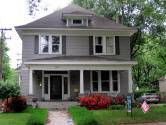 |
 |
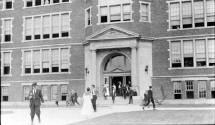 |
 |
| The Barnes Home |
Idlewild School |
Central High
School |
Mississippi A and
M |
|
|
|
|
|
|
During his brief 4 months at Mississippi A and M, George fell in
love with Geneva Ramsey. They were married when he was 19 and in
the next two years had two sons, George Jr. and Robert.
Geneva was close to her parents George and Della York Ramsey.
Kelly admired his father in law and the two developed a mutual
respect. But Ramsey died as a result of a dynamite
accident in 1920 and George was devastated. He then began a
period of one failed job after another. To support the
family George quit college and took various jobs, including taxi
driver - working long hours for little pay. It just wasn't
enough. Eventually the strain caused George and Geneva to
separate. |
 |
| |
Geneva Ramsey |
|
|
|
|
About this
time he took up with a small time gangster and began a new venture as a
bootlegger. The monetary rewards were impressive and Barnes enjoyed
the new notoriety. It was too late to save the marriage.
Geneva divorced George Barnes, because of the "disreputable company he
kept". |
|
|
|
|
|
|
|
|
|
|
 |
 |
In
the 1920s George met Cleo Brooks and they became a couple.
She had changed her name to Kathryn and by all accounts she was a "lady" who knew "more buns than the
Police Department ... who could drink liquor like water. and had
some of the toughest women friends one ever laid eyes on..."
She already had a record for shoplifting, robbery and prostitution. Her mother
Ora, was said to be her equal in all those departments. So
Kathryn would have no trouble accepting George's "disreputable
company".
George continued his businesses, but after several
run-ins with the local Memphis police, he and Kathryn decided to leave
town and head west. |
|
Kathryn |
Kathryn |
|
|
|
|
|
Kathryn's mother
Ora was married to John Emory Brooks when she was born. Ora later
married a gentle, well-respected Texas farmer named Robert
"Boss" Shannon. She convinced Boss to rent his ranch to criminals as
a hideout while she bootlegged. Another victim of this period is
rarely mentioned: Kathryn's daughter by a previous marriage, Pauline
Fry. She was a teenager and was lived with Ora and Shannon because
Kathryn was off committing robberies with George Barnes.
|
|
|
 |
 |
 |
 |
 |
 |
|
John Emory Brooks |
Brooks-Ora-Cleo |
Pauline - Ora |
Ora
working at a store |
R. G.
Shannon |
Boss
Shannon |
|
|
|
|
|
|
 |
To protect his family and escape law enforcement, Barnes changed his
name to George R. Kelly. The "R" was for his first wife 's
father "Ramsey". George continued to commit small crimes but
the bootlegging got him arrested in Tulsa, and sentenced to 3 years at
Leavenworth Penitentiary. He was a model prisoner and earned
early release. Shortly afterwards he and Kathryn were married
and embarked on a life of crime. Legend has it that Kathryn then
created the Machine Gun Kelly image. She had purchased the first
Tommy gun that George ever owned and made him practice using it.
She then handed out spend cartridges to friends and relatives as
souvenirs. It's said that she also planned some of their
escapades. The "machine gun" legend grew as kelly became involved in bank
robberies in several states.. |
| The Kelly's |
|
|
 |
 |
 |
 |
 |
| Early
Mug-Shot |
Leavenworth Prison |
George |
Movie |
Kathryn |
|
|
|
|
|
|
|
 |
After
years of boot-legging, bank robberies and numerous little crimes, the Kelly's hit
"big-time" with their next job: the kidnapping of wealthy Oklahoma
City oilman Charles F. Urschel in 1933. Kathryn had
planned the kidnapping and the couple, along with Kelly accomplices,
Albert Bates and Harvey Bailey, completed the job and successfully
extracted a $200,000 ransom from the victim. |
 |
| Chas. F. Urschel |
|
Urschel Home |
|
|
|
|
The Kelly Gang
brought the blindfolded Charles Urschel to the Texas ranch of
Kathryn's parent's, Ora and "Boss Shannon. In return for a cut of the ransom moeny Boss Shannon
and his son Armon agreed to watch Urschel while Kelly hangled the
negotiations. After the ransom was paid, Urschel was released, but
he
had been
very clever during his kidnapping, and was able to provide multiple clues which led
to the ultimate capture of the Kellys. |
|
|
|
|
|
|
|
On August 12,
Federal agents raided the ranch, arresting three of Kelly's in-laws
and Harvey Bailey. Kelly and Kathryn had left by this time and
Albert Bates, Kelly's partner had moved on and was arrested the next day
in Denver, spending some of the ransom money. Kelly and Kathryn
evaded capture for several weeks.. |
|
|
|
|
|
|
|
|
|
|
|
|
|
On the morning
of Tuesday, September 26, 1933, Memphis police, along with FBI Agents,
surrounded a bungalow at 1408 Rayner Street owned by Kelly's longtime friend
John Tichenor. The
agents then made a violent forced entry. As legend has it, at that moment, Kelly
coined the phrase: "G-Men, please don't shoot." Kelly was
found badly hung over from the prior evening's drinking binge and still in
his pajamas". |
 |
| |
1408 Rayner St. |
|
|
|
|
|
|
|
 |
 |
 |
 |
 |
 |
|
Kathryn Mug |
The
Capture |
Court
transfer |
Shackled |
Shackled |
Airport transfer |
|
|
|
|
|
|
|
|
|
 |
By the time
Kelly and Kathryn were arrested in Memphis, the trial had already
begun in Oklahoma City and the couple were quickly
transferred to Oklahoma.
The trial resulted in
several historical events: The first federal criminal trial in which
film cameras were allowed; the first kidnapping trial after the passage of
the Lindbergh Law; the first major case solved by J. Edgar Hoover's FBI,
and the first prosecution in which defendants were transported by
airplane.
|
| Kelly Confesses |
|
|
The
prosecution pronounced that "the interest of the nation is focused on
the drama now coming to a close in this courtroom. We are here
to find an answer to the question of whether we shall have a
government of law and order or abdicate in favor of machine gun
gangsters. If the government cannot protect its citizens, then
we had frankly better turn it other to the Kellys, the Bates, the
Baileys and the others of the underworld and pay tribute to them
through taxes." |
 |
| |
Kelly Confesses |
|
|
|
 |
 |
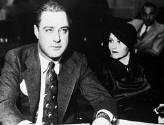 |
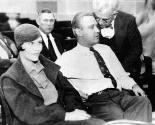 |
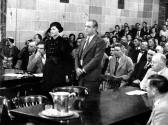 |
|
Kathryn |
George-Kathryn |
George-Kthryn |
KKathryn-Georgea |
Sentence |
|
|
|
|
George didn't take the
stand in his own defense. He and Kathryn Kelly were convicted and
sentenced to life imprisonment. Kathryn's mother Ora was also sentenced to
life for her part in the kidnapping, and her step-father "Boss" Shannon
was sentenced to a shorter term.
Armon Shannon received a probationary sentence because he cooperated
with the government. Accomplices Harvey Bailey and Albert Bates were
also sentenced to life in prison. The sentences
completed the Urschel kidnapping case and brought closure to the first
trial in the nation to invoke the Lindbergh Kidnapping Law.
|
|
|
 |
 |
 |
 |
 |
 |
|
George and
Attorney |
Kathryn-Ora-Shannon |
Bates-Bailey-Armon-Boss-Ora |
Boss
Shannon |
Boss Convicted |
Kelly |
|
|
|
|
George Machine Gun
Kelly was transferred to prison where he would spend his remaining 21
years. 17 of those years were at Alcatraz, where he swore he would
escape. At Alcatraz he got the nickname "Pop Gun Kelly" in
reference to the fact that he was a model prisoner and nowhere near the
tough, brutal gangster his wife made him out to be. As inmate
#117, he worked in the prison industries, where he exaggerated his past
escapades to the other inmates.
|
|
|
 |
 |
 |
 |
 |
|
Harvey Bailey |
Albert Bates |
Ora -Boss shackled |
Alcatraz |
George-Alcatraz |
|
|
|
|
|
|
|
|
Because Kelly had been a model prisoner at Alcatraz prison, he
was quietly transferred to Leavenworth in 1951, where he died of a
heart attach on his 59th birthday in 1954. Kathryn and Ora were
still in prison, but "Boss" Shannon was out, living in Paradise,
Texas. Kelly's body was shipped to Shannon, who arranged the funeral
at nearby Cottondale, Texas. Armed FBI agents were in
attendance at the funeral. All was very quiet. |
 |
| |
Kelly at Alcatraz |
|
|
|
 |
 |
 |
 |
| Death |
Coffin arrives in
Texas |
Funeral |
Grave |
|
|
|
|
Kathryn and her mother
were not permitted to attend the funeral. They were released
from prison in 1958 based on "circumstantial evidence" in the trial.
Kathryn was 54 and slipped quietly into obscurity as a bookkeeper in
an Oklahoma hospital. Ora died in 1980 and Kathryn died in 1985.
They are both buried in Oklahoma. Tales persist that
before the trial, both of them tried to strike a deal and sell Kelly
down the river. No hard evidence has surfaced.
Accomplice Harvey Bailey was released from prison in 1964 and died in
1979. Kelly's long-time partner Albert Bates died in Alcatraz in
1948 of heart disease.
|
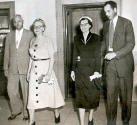 |
| |
Ora - Kathryn 1958 |
|
|
|
|
Most
historians feel that George Barnes would only be a footnote in crime
history were it not for kathryn Kelly. |
|
|
|
|
|
After
divorcing George, Geneva Barnes married Frank Trimbach around 1927 and he
adopted her two sons by George. They divorced in 1940 and she later
married Frank Williams. Geneva died in 1997 in California and her
ashes were buried next to her parents in Memphis Elmwood Cemetery.
George's son Robert Owen Bruce Barnes developed a relationship with Kelly
when he was in Alcatraz and later wrote a book about his father, "To
right a wrong". He died in 2010 and is buried in California.
George's son George Ramsey Barnes Trimbach never communicated with his
father after the trial. He died of a heart attack in 1989 and is buried in California. |
|
|
 |
 |
 |
 |
 |
 |
 |
|
Robt.O.Bruce Barnes |
"To
Right a Wrong" |
George R. Trimbach |
Geneva
|
Armon |
Boss
Shannon |
Pauline |
|
|
|
|
Boss Shannon
died in 1956 and is buried between his first and second wives - a short
distance from the grave he supplied for George Barnes. His son Armon
returned to Texas after the trial, where he lived the remainer of his
life. He eventually married three times and had seven children.
Pauline Fry?
An Oklahoma aunt took her in. She wanted to become a teacher,
but there were no funds. Judge Vaught from the Kelly trial
advised her that an unknown benefactor had offered to pay for her
tuition and living expenses. Pauline did become a teacher,
married, had two children and eventually reunited with her mother and
grandmother. She died in 2005 and is buried in Oklahoma.
After Judge Vaught's death, his family located files that showed
Pauline's unknown benefactor was none other than Charles Urschel. |
 |
|
Boss' Obit |
|
|
|
|
|
|
|
|
|
|
Various mug-shots of George Kelly |
|
|
|
|
|
|
|
WANTED posters of George Kelly .
a couple appear to be "photo-shopped". |
|
|
|
|
|
|
|
|
|
|
|
|
|
|
|
Note:
The court
documents, files, and photos relating to the Kelly trial are in Public
Domain |
|
|
|
|
|
|
|
|
|
|
|
|
Credits |
|
|
|
The
Historic-Memphis website does not intentionally post copyrighted
photos and material without permission or credit.
On
occasion a "non-credited" photo might possibly be posted because we
were unable to find a name to give credit. Because of the nature of
our non-commercial, non-profit, educational website, we strongly
believe that these photos would be considered "Fair Use. We have
certainly made no monetary gain, although those using this website
for historic or Genealogy research have certainly profited. If by
chance,
we have posted your copyrighted photo, please contact us, and we'll
remove it immediately, or we'll add your credit if that's your
choice. In the past, we have found that many photographers
volunteer to have their works included on these pages and we'll
also do that if you contact us with a photo that fits a particular
page. |
|
|
|
The "Historic-Memphis" website would like to acknowledge and thank the
following for their contributions which helped make this website
possible:
Memphis
Public Library, Memphis University Library, Memphis Law Library,
Memphis Commercial Appeal, Memphis Press Scimitar, Shelby County
Register of Deeds, Memphis City Schools, Memphis Business Men's
Club, Memphis Chamber of Commerce, Memphis City Park Commission,
Memphis Film Commission, Carnival Memphis, Memphis Historical
Railroad Page, Memphis Heritage Inc, Beale Street Historic District,
Cobblestone Historic District, Memphis Historic Districts, Vance
Lauderdale Family Archives, Tennessee State Archives, Library of
Congress, Kemmons Wilson Family, Richard S. Brashier, Lee Askew,
George Whitworth, Woody Savage and many individuals whose assistance is
acknowledged on the pages of their contributions. Special
thanks to Memphis Realtor, Joe Spake, for giving us carte blanche
access to his outstanding collection of contemporary Memphis photos.
We do not have high definition copies of the photos on these
pages. If anyone wishes to secure high definition photos,
you'll have to contact the photographer or the collector.
(To avoid any possibility of contributing to SPAM, we do not
maintain a file of email addresses for anyone who contacts us). |
|
|
|
|
|
|
|
|
historic-memphis.com |
|
|
|
|
|
|